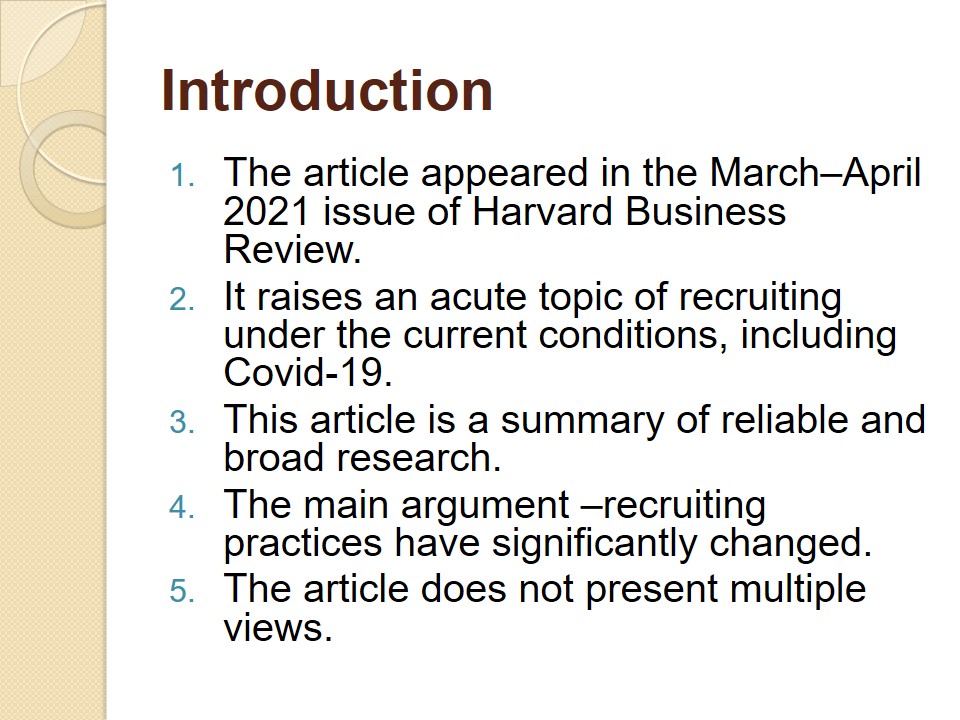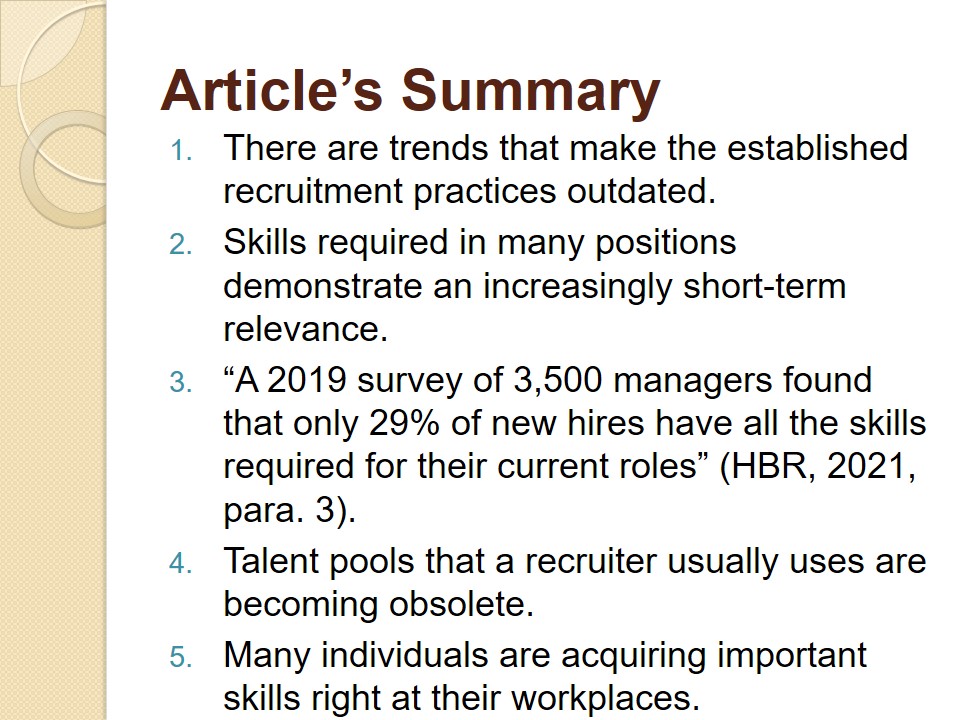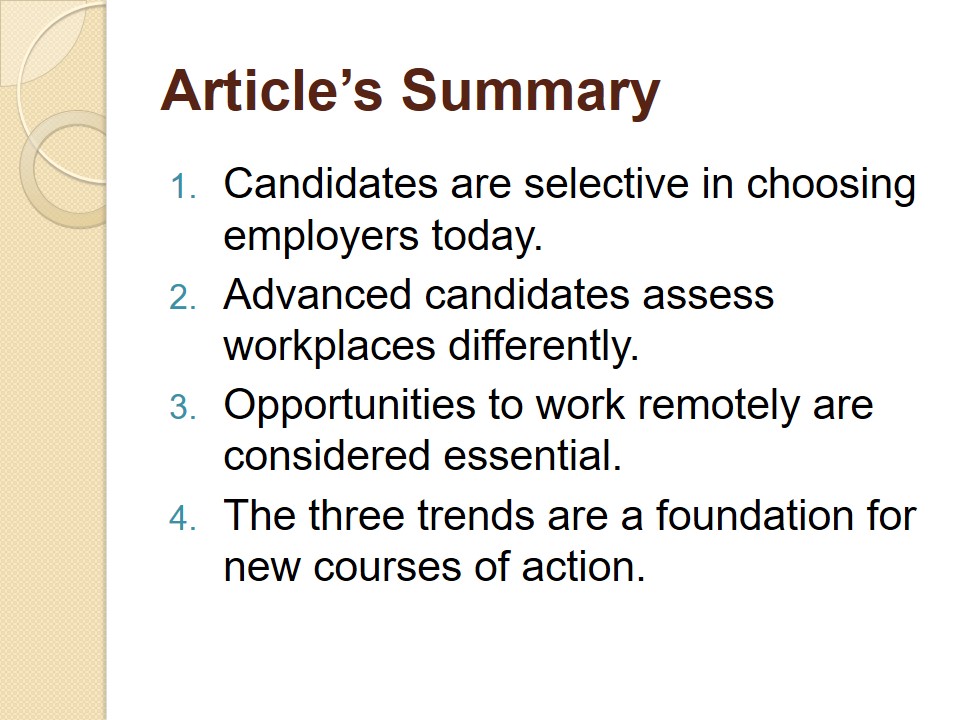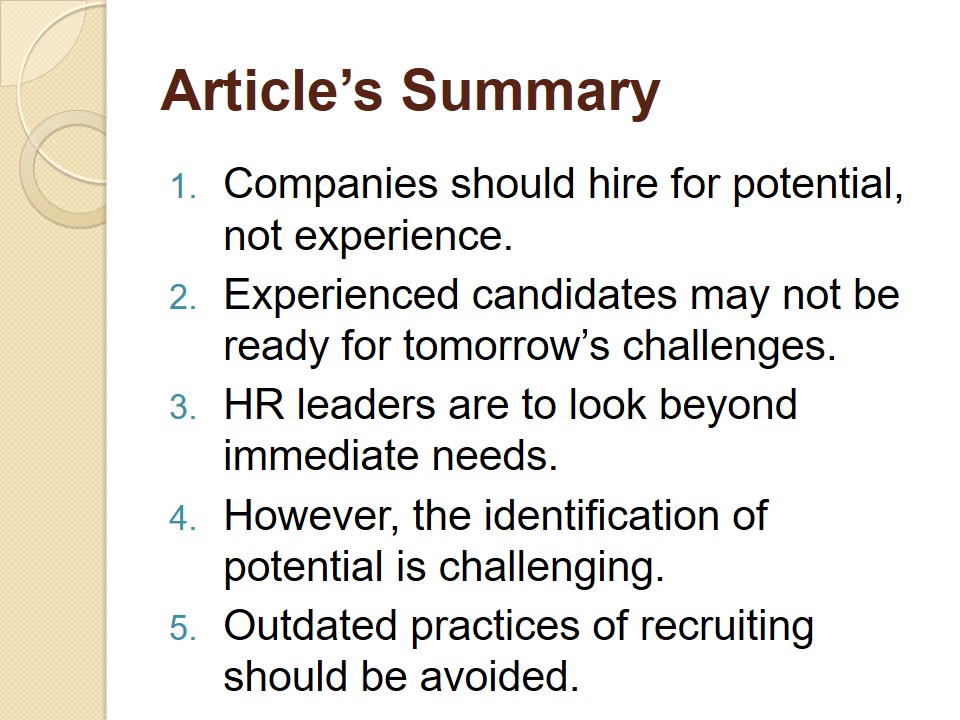Introduction
- The article appeared in the March–April 2021 issue of Harvard Business Review.
- It raises an acute topic of recruiting under the current conditions, including Covid-19.
- This article is a summary of reliable and broad research.
- The main argument –recruiting practices have significantly changed.
- The article does not present multiple views.
- The title is “Reengineering the Recruitment Process,” and the article has no specific author.
- Hence, the relevance of the publication might be apparent.
- The study itself was conducted by research and advisory company – Gartner.
- It is claimed that there are “shifts in the workforce landscape,” and the research “lays out a road map for navigating the new one” (HBR, 2021, para. 2).
- The publication is not a critical summary but rather a provision of crucial ideas, findings, and propositions of the research.

Article’s Summary
- There are trends that make the established recruitment practices outdated.
- Skills required in many positions demonstrate an increasingly short-term relevance.
- “A 2019 survey of 3,500 managers found that only 29% of new hires have all the skills required for their current roles” (HBR, 2021, para. 3).
- Talent pools that a recruiter usually uses are becoming obsolete.
- Many individuals are acquiring important skills right at their workplaces.
- Candidates are selective in choosing employers today.
- Advanced candidates assess workplaces differently.
- Opportunities to work remotely are considered essential.
- The three trends are a foundation for new courses of action.
- Companies should hire for potential, not experience.
- Experienced candidates may not be ready for tomorrow’s challenges.
- HR leaders are to look beyond immediate needs.
- However, the identification of potential is challenging.
- Outdated practices of recruiting should be avoided.
- Companies should move beyond Ping-Pong and free snacks.
- The way firms address Covid-19 is important.
- Companies can use various tools to monitor job expectations.
- Current challenges led to significant alternative practices.
- Indeed, the today’s markets’ conditions are not stable, which is reflected in almost every sphere of life.
- Partially, this is due to more constant technological breakthroughs.
- The mentioned percentage would be even lower for future roles.
- Significant candidates may be found not only in universities and other recognized educational establishments.
- Crucial knowledge may also be obtained from online courses.
- Thus, companies should provide a significant employment value proposition. It may include anything – starting from incentives and ending with development opportunities.
- Aspects such as “meaningful work and proximity to family” are of an increased value due to the pandemic (HBR, 2021, para. 5).
- In conjunction with the possibility to manage schedules, these opportunities have increased job-seekers’ expectations that they may design their working routine to an exact extent.
- It should be emphasized that if companies do not take these trends into account accordingly, they are threatened to meet both high turnover rates and low workforce inflows.
- The initial phase in the framework of adaptation to the mentioned trends is to stop hire individuals in order to replace particular employees – the scope should be broader.
- Experience is a great foundation for significant performance, but it cannot be perceived as an imperative aspect that forces HRs to hire a candidate.
- Recruiters should consider which skills the larger company is to possess via its employees to remain successful in the long run.
- It is quite difficult to design appropriate assessments that identify potential reliably.
- HRs should pay less attention to academic degrees, work experience and focus on significant talents, the presence of critical thinking, and the search for candidates worldwide, given remote work opportunities.
- For organizations, it is essential to realize how potential employees perceive them, as well as to figure out ways to improve these perceptions.
- Today, candidates scrutinize companies’ reactions to Covid-19 in order to find out how these firms have provided help to their staff to establish convenient conditions for work.
- There are many examples of advanced corporations that have focus groups responsible for monitoring job-seekers’ expectations, “benchmark their offerings against those of competitors, and scour social media and job-review sites” (HBR, 2021, para. 12).
- The final assumption of the research presented in the article is that despite the pandemic caused a plethora of drastic issues, it also contributed to the development of alternative significant recruiting practices and ideas.




Conclusion
- The article provided a summary of the notable research.
- Relevant issues were raised and delivered clearly.
- Rationale is consistent and coherent.
- The main ideas can and should be applied in practice.
- Gartner has provided a relevant study that explores the current keen aspects of recruitment.
- Challenges were formulated briefly but exhaustively, and the directions to solve them are emphasized.
- The article has a smooth transition from one idea to another.
- Given the evidence cited in the article, the primary assumptions and suggestions of the research seem appropriate to me as, indeed, the pandemic has transformed the recruiting sphere substantially, and the proposed actions for companies address these changes.

Reference
HBR. (2021). Reengineering the recruitment process. Harvard Business Review. Web.